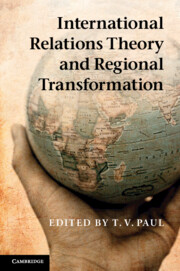Book contents
- Frontmatter
- Contents
- Figures and tables
- About the contributors
- Acknowledgments
- Part 1 Introduction
- Part 2 Realist perspectives
- 3 Realism and Neorealism in the study of regional conflict
- 4 Neoclassical realism and the study of regional order
- Part 3 Liberal perspectives
- Part 4 Constructivist perspectives
- Part 5 Eclectic perspectives
- Part 6 Conclusions
- Index
- References
4 - Neoclassical realism and the study of regional order
Published online by Cambridge University Press: 05 June 2012
- Frontmatter
- Contents
- Figures and tables
- About the contributors
- Acknowledgments
- Part 1 Introduction
- Part 2 Realist perspectives
- 3 Realism and Neorealism in the study of regional conflict
- 4 Neoclassical realism and the study of regional order
- Part 3 Liberal perspectives
- Part 4 Constructivist perspectives
- Part 5 Eclectic perspectives
- Part 6 Conclusions
- Index
- References
Summary
Introduction
T. V. Paul observes in this volume’s introduction that regional transformation – the conditions under which some geographically delimited regions are more likely to evolve toward greater cooperation and peaceful relations among their constituent states, while other regions remain trapped or degenerate into enduring rivalries and endemic interstate and intrastate war – is “of the utmost importance for crafting appropriate policy initiatives.” He defines a region as “a cluster of states that are proximate to each other and are interconnected in spatial, cultural, and ideational terms in a significant and distinguishable manner.” Regions, therefore, are a defined subsystem within a broader international (or interstate) system. According to Robert Jervis, we are dealing with a system when there are (a) a set of units or elements interconnected so that changes in some elements or their relationships produce changes in other parts of the system, and (b) the entire system exhibits properties and behaviors that are different from those of the constituent parts. Further, as Barry Buzan points out, “regions” are recent historical phenomena. The existence of a single international system of a sufficient geographic scope and interaction capacity to comprise multiple regions only dates to the eighteenth and the nineteenth centuries.
Between 1848 and 1945 Prussia and its successor state Germany initiated six interstate wars, the Schleswig–Holstein wars of 1848–49 and 1862, the 1866 Austro-Prussian (or Seven Weeks’) War, the 1870–71 Franco-Prussian War, World War I, and World War II. During approximately the same period Japan initiated five wars: the First Sino-Japanese War of 1894–95, the Russo-Japanese War of 1905, the Manchurian (or Mukden) Incident of 1931, the Second Sino-Japanese War of 1937–41, and the Pacific theater of World War II. Yet since their respective defeats in 1945, neither Germany nor Japan has threatened to use force, let alone actually gone to war, against its neighbors. Western Europe has not experienced an interstate war, let alone a major (or hegemonic) war, in almost seventy years. Similarly, since the Korean War armistice in 1953, there have been no full-fledged great power wars in East Asia, although there have been a number of crises that risked escalation to war, most recently the 1995–96 Taiwan Strait Crisis. There have been four instances since 1945 where China has gone to war, albeit against adversaries outside of Northeast Asia or against great powers that intervened in existing conflicts in the region. These include China’s intervention in the Korean War in 1950–53, the Sino-Indian War in 1962, Sino-Vietnamese War in 1979, and the Sino-Soviet border clashes in 1969. For a variety of reasons – nuclear deterrence, the bipolar distribution of power in the global system, and power asymmetries between combatants – none of those conflicts escalated to a regional level. Nonetheless, compared to the respective dynamics in the pre-1945 (or pre-1953) era and compared to other regions of the globe today, both Western Europe and East Asia have been remarkably stable.
- Type
- Chapter
- Information
- International Relations Theory and Regional Transformation , pp. 74 - 104Publisher: Cambridge University PressPrint publication year: 2012
References
- 8
- Cited by



